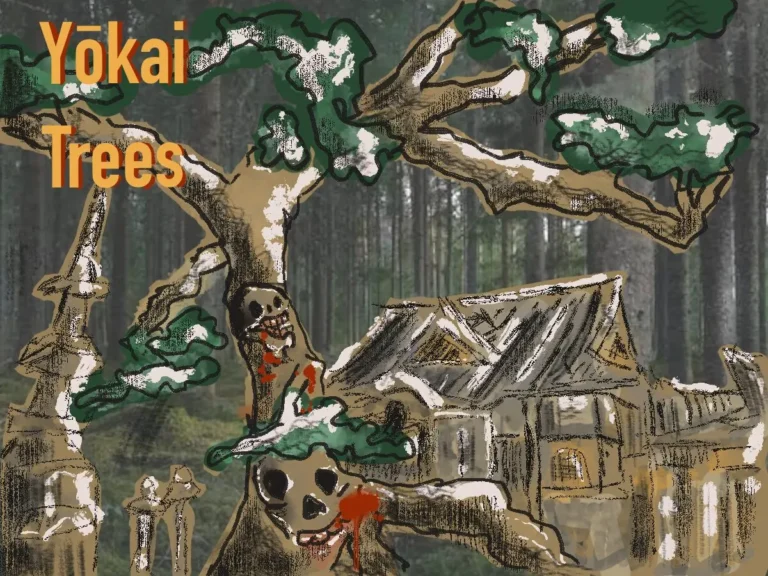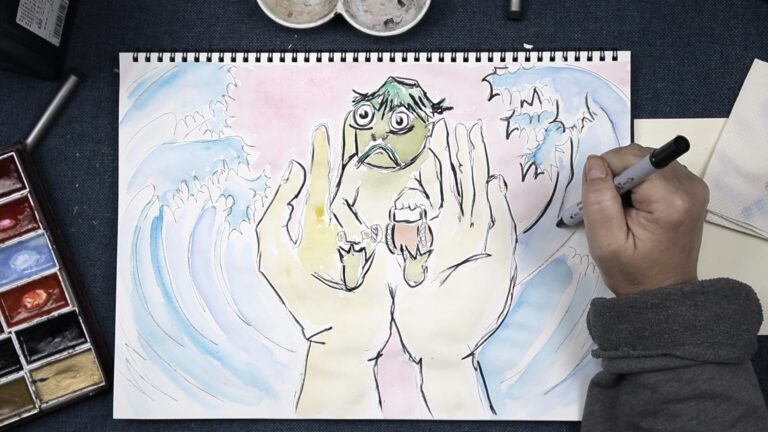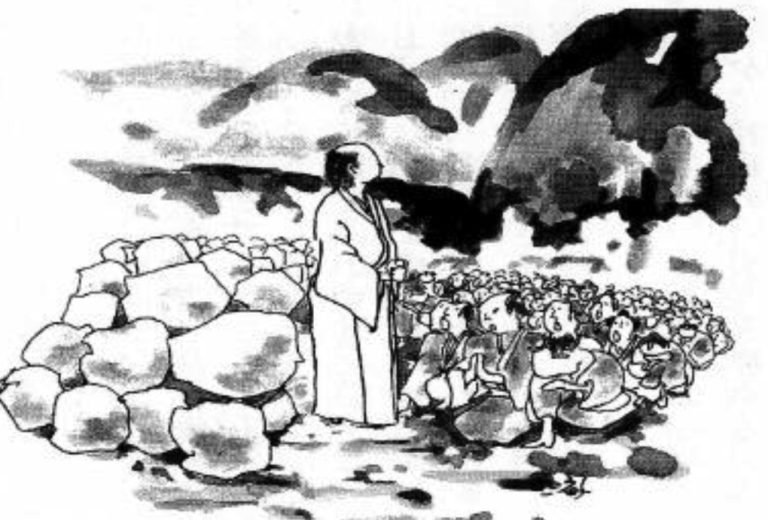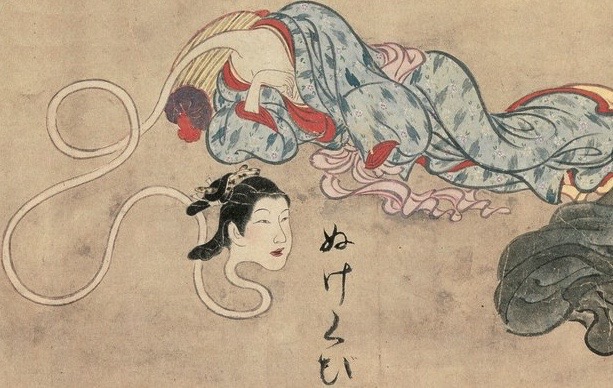This is Thersa Matsuura and you’re listening to Uncanny Japan.
It’s Halloween. Do you want to hear a scary Japanese legend? And my new bright idea?
Keep listening.
Intro:
Hey hey, how are you? Are you okay? Are any of us okay? Today I’m going to tell you a tale of a woman who was very much not okay. But then she took matters into her own hands and kind of was okay. Then not okay again. Believe me, it’s more exciting than that.
New Audio Shorts
But first let me mention briefly my bright idea. I get a lot of messages and emails — and I love it, thank you so much, I apologize if I can’t write back right away — but through the years, I’ve identified two issues and I think I’ve come up with a solution.
First, listeners who would like to support me, my writing, the show, but don’t like, aren’t interested in, or are unable to do the subscription model that is Patreon. That’s cool. Totally understandable. There’s the Kofi and Buymeacoffee option — again, thank everyone who’s helped there. But I want to give something back in return and haven’t quite figured out how to do that on either of those platforms.
The second thing I hear quite a bit is people who love these old folktales, lore, legend and myth and would like to hear more. Again, perhaps they aren’t into Patreon or would instead like to pick and choose which stories they listen to. Maybe they don’t like the especially horror-tinged ones, or maybe they DO like them and only them.
So somewhere along the way, I imagined a Venn Diagram of those two groups and where they intersect is my bright idea.
I’m going to start putting my translated, retold, and often reimagined folktales up as audio shorts. If that sounds familiar, yes, it’s very similar to what I do monthly on Patreon, but over there I like to experiment, read some other “in public domain” pieces, essays, Lafcadio Hearn, or maybe read my own serialized Asahi newspaper story. With these new audio shorts, though, there will be a format, the folktale or legend and then at the end a short commentary where I talk about my thoughts and any interesting research I found along the way.
And of course, $5 and up Patrons will be getting these, too, as regular content when I get them done. Another plus is that I found an audio book distributer that isn’t a monster — like the A word — and when you buy any of their audio books you get to choose a local or indie bookstore and they split their profits with them. So instead of buying Bezos more houses, penthouses, jets, yachts, or rocketship companies, we can put money back into our communities.
I’ll tell you more in a minute about how to get the first story which is my retelling of “Kwazu Nyobo/The Wife Who Didn’t Eat”.
Uji no Hashihime–The Maiden of the Bridge
But first, let’s get to today’s show. Cue, creepy, slightly Trent Reznor-esque music by my son Julyan. Now, if your home alone and it’s nigh time, light a couple candles. Close your eyes.
Today’s chill bump inducing-legend is my retelling of the classic “Uji no Hashihime, The Bridge Maiden of Uji”. I’m going to do this one in the same format as the audio shorts, so you can get an idea if it’s something you’re interested in or not. So after the story, I’ll add some commentary, research notes, and thoughts.
But first, the story of Hashihime has been told for over a thousand years. And one thing I’ve noticed in every version I’ve ever read or heard is that the focus is always on the action our protagonist takes, (and yes, she’s the protagonist in my eyes ). We love the horrible part that comes later. Sadly, there’s usually only a single line or two about WHY she does what she does. What drives her to this unthinkable deed?
Little to nothing is known about the young woman herself and who she is, which really is the story. So let me start with a couple of things I imagine to be true for this legend to make more sense, be more potent, and to have endured for so long.
Who was this Maiden?
Mukashi mukashi, Let’s start with a young woman who has fallen in love. She may be rich or poor or somewhere in between, but what is true is that she has given her heart to a man and believes this is a love that will last forever. She’s not cynical or suspicious and she has never been hurt by anyone before. She believes in the goodness of people. And if we dislike her for this, maybe it says more about us, than about her.
What is important to note, though, is that what our young maiden does later isn’t because she was evil or malicious at heart, it’s the opposite. It’s because she was good and hopeful and innocent, and then she was betrayed.
Our maiden falls in love and gets married and I’m guessing moves away from her family and friends; everything and everyone she’s ever known. Maybe it’s her husband’s job that takes them to Kyoto. But now she is alone in this big beautiful, magical city, except for her dear husband who is working hard at whatever job he has. From here everything should be happily ever after. Our maiden is keeping the house and probably readying it for the family she hopes to raise soon. Meanwhile, her husband is coming in late every night exhausted. She feels for him, wishes his work wasn’t so difficult. She supports him in any way she can.
This goes on for a long time. Until one fateful day she discovers her husband is having an affair and been lying to her this whole time. All that love and affection she had received when they first met is being lavished on another. There are probably more details that make her situation even more unbearable. Maybe she was unable to have the child she so desperately wanted and yet learns this mistress is pregnant with her husband’s baby? Is he cruel to her? Does he tease her? Nowadays we might leave these circumstances, find help, but it wasn’t so easy back then. Perhaps she is unable to return home to her family for whatever reason, distance, money, shame. And so she is entirely alone, broken hearted, deceived, and she must live every day in that house knowing what she knows with no support at all. Maybe he comes home, maybe he doesn’t.
She broods. Sadness growing into bitterness, helplessness growing into rage. Hate.
Our maiden, at this point, goes a little bit mad. Under the circumstances, understandable.
She Goes to Kifune Shrine
Somehow she learns about Kifune Jinja or Kibune Shrine in northern Kyoto, where an extremely powerful water goddess called Takaokami (高龗神) is enshrined. Our maiden walks for hours through the city and up the steep slopes of Mount Kurama to this shrine. It’s dark when she arrives. Still she prays fervently for help, an answer, revenge? When she is done she turns and walks all through the night back home.
The next day, she wakes, dresses, and with blisters on her feet, legs sore, she makes the long trek and returns to Kifune Shrine. She repeats her prayer, her pleading. This time with an emphasis on the request for revenge.
The following day, day three, she goes again. Physically weaker, but her mind is sharper and more focused. As she walks through the city she looks around and understands there is no place or person she can turn to for help. No one. She imagines herself a swift flowing river, like the Kurama River which she walks along for some way. Finally, she reaches the bridge to cross over it and stops in the middle, waning moon overhead, the leaves just starting to turn in early autumn. She gathers her strength and goes across, and climbs the footpath and then the steps that lead to the shrine. Again she prays.
She returns the next day. Day four. Day five. Day six.
The Goddess Takaokami Feels Pity for Her
Meanwhile, the goddess, Takaokami, is really feeling the girl’s pain and admiring her determination. She’s empathizing with the maiden. She understands this hate and need for revenge. The goddess doesn’t like to encourage such things, being a goddess and all, but she does have the power to make it happen. Then the young woman gets more specific in her prayers. She implores Takaokami: please I am so weak, there is nothing I can do, but if I am turned into a living oni, I can exact revenge my revenge on this horrible man who continues to torment me. The goddess gets and idea.
The Goddess Gets a Priest to Help Deliver a Message
On the night before the seventh visit, up the mossy stone steps of Kifune Jinja, in a back tatami room lit by a single oil lamp, a certain Shinto priest wakes suddenly from the most disturbing dream he’s ever had. In it the water goddess Takaokami has come to him and orders him to pass a message on to a mysterious woman who will be making a visit to the shrine soon, even though it is very late.
Not wanting to incur any divine wrath, the priest dresses and hurries down to the gate to meet the woman. What the goddess has told him to do, he does not want to do. It deeply disturbs him. But he is just a man and cannot, will not, disagree with the goddess who chose him and who is believed to be a great dragon who controls all water, rain, and snow.
As soon as he reaches the gate, he sees a beautiful young woman approaching from the other direction.
It’s exactly as the goddess predicted. He bows and greets her and says:
“Tonight in my dreams Takaokami came and commanded me to pass along her message to you. The goddess says your prayers have been heard and you will be allowed to become a living oni-demon in order to get revenge on your miserable husband. You know longer need to come here anymore.
Instead, return home and sew yourself a red kimono. After it is finished, rub vermillion paste all over your face, neck, and body, keeping in your chest the rage you feel, the all encompassing need for retribution.
Once your skin is dyed the deep crimson of an oni. Put on the kimono and tie your hair up into five horns. Then take an iron trivet and turn it upside down, place it on your head, so that it rests there like a heavy metal crown. Upon the three legs of the stand, tie small pine torches and light them. Finally, take two more lit torches and clench them in your teeth so they hang from either side of your mouth.
In this manner, imagine you’re a great oni, you may leave the house and walk to the Uji River. Once there, immerse yourself in its water. Feel your heart change, your body change. Feel yourself become more powerful, feared by all people.
Perform this ritual for 21 nights. On the last day, your transformation will be complete and you may visit your husband and do as you wish. With that the priest bows again to the woman and flees back to his room.
The Young Woman Performs the Ritual
The young maiden does exactly as she is told. Every day for 21 days she uses cinnabar to paint her skin and dons her red kimono. She ties up her hair, places, and lights the iron crown. Slowly, she makes her way through the streets, two burning twists of pine held tight in her wicked teeth. She strikes terror in the heart of everyone who sees her. Screams, gasps. People running away, locking doors. But she doesn’t care, she feels herself growing stronger. She is changing. On the twenty first night, she emerges from the Uji River as Hashihime.
Her Husband’s Nightmares and Abe no Seimei
Meanwhile, the whole time this is going on, the young woman’s husband is also having nightmares. Nightmares that are growing worse as the days go by. As the maiden grows farther from her innocent self and closer to the demon she is meant to be. Finally, he can’t take it any longer and calls upon the famous onmyouji, Abe no Seimei, the most powerful mystic in all of Japan.
Abe no Seimei recognizes these dreams. He explains what is happening to the husband and says there is nothing he can do to help. The wife’s single minded purpose to punish him and do him harm coupled with her getting the gods attention, sympathy and help is a mighty thing. Also, Seimei mentions, tonight is the night his newly turned oni wife is planning to come and murder both him and his lover in their sleep.
But the husband begs and begs until Abe no Seimei finally agrees to do what he can. Two straw dolls are put together and dressed and placed inside the futons of the couple. Seimei prays long and hard to any deity who will listen.
Hashihime Arrives
Finally, night comes and everyone hides. Hashihime sweeps into the house like a storm, kimono blowing about her, her skin burnished red, black eyes shining, reflecting the firelight from the torches she carries in her hair, she holds a large club in one hand. Seimei’s magic briefly covers the straw dolls from her sight. She doesn’t notice it’s not them.
Hashi Hime kneels beside what she thinks is her sleeping husband. She whispers:
“When we were married, I believed it would be for a thousand years, but instead you’ve dashed my heart for no reason other than your own selfishness. Having been dismissed by you, my sorrow overwhelms me, while still I cry tears of love.
Mocking you. Missing you. Blaming you. Each day and night, wakeful or sleeping, suffering without end. Revenge. Revenge for the fallen, revenge for the forgotten, revenge for all those cast aside. “These thoughts whirl like black leaves tossed by gales in the Demon’s mind. “I must take your life, and the gods forgive me, you pitiable man!”
Abe no Seimei’s Magic
Hashi Hime then strikes hard with her club, the effigies of her husband and his lover. Again and again. But soon she notices the trick. At that moment Seimei’s magic takes over and rising and swirling around the mad and broken oni, commands her to leave the house.
Hashi Hime screams out. Abe no Seimei confronts her and the maiden of the bridge calms and chuckles to herself. She sees her husband and his lover cowering and peeking from behind a folding screen in the corner of the room. She realizes that tonight she will not be allowed the revenge she was promised. She deserves. She speaks:
“You must understand. My resentment will never end.” Then catching her husband’s eye.”Somewhere, somehow, we will meet again.”
Her presence softens, her body turns to mist and she disappears.
The end.
Commentary
I always say this, but I’m going to say it again. There are many different versions and interpretations of Hashihime of Uji. Some have her waiting by a bridge for a lover, some have her husband killed in a battle and she’s expecting his return. In some she’s married, divorced, in others the man in question is just her lover. This version is mine, but it follows quite closely to the Noh Play called The Iron Crown/Kanawa.
There’s even one bit I borrowed from the play and that is when Hashihime addresses her husband at the end. I thought her little speech was nice.
Her Connection to Ushi no Koku Mairi
You’ll also note that the tale is called Hashihime of Uji. There are other Hashihime’s out there. But I believe hers is the first. And speaking of first, remember Episode 52: Putting a Curse on Your Enemies. Ushi no koku Mairi? Well, Hashihime is believed to be the impetus for that practice, marching into a forest with candles in your hair and banging an effigy of your enemy to an old tree.
Her Connection to Hitobashira
Somewhere along the way the Hashihime legends got entwined with the Hitobashira practice. Remember hitobashira, episode 81, when people were sacrificed to the gods to make an embankment, castle wall, tunnel, or bridge stronger. So sometimes you’ll hear mention of a hashihime and it will be referring to a poor soul who was killed in order to strengthen or bless a bridge.
Protecting God and Guardian
So hashi means bridge. Something that joins one piece of land to another, connects here to there. In Japanese it’s called genkaisen, or boundary line. This genkaisen connects this world, this reality we’re living in to the world on the other side, the place where spirits, both malicious and godly dwell. Hashihime, her name literally meaning Bridge Princess, was able to make that connection. Move from one to the other.
Another thing about the different Hashihime tales, is that in some they are jealous demon spirits, while in others they fiercely guard a certain bridge, perhaps from invaders. They are a kind of mamori gami or protecting god. People prayed to their hashihime, a guardian deity of genkaisen, boundary lines. The outside enemies she protected you against, could be real human types bad guys, or disease.
Hashihime as Jealous Spirit
Yet still, her legend is strong and it’s said that if you stand on a Hashihime bridge and praise another bridge or if you sing either of the songs: “Aoi no Ue” or “Nomiya” which are about a woman’s jealousy, then the most heinous of curses will befall you.
People are so careful even today not to incur our demon/guardian’s wrath, that if their is a wedding procession, it will not cross a Hashihime’s bridge or pass one of her shrines. You don’t want her to see a beautiful bride or happy couple and be reminded of what happened, oh, a thousand years ago and fall into a jealous rage.
My Visit to the Uji no Hashihime Shrine
Speaking of the Hashihime Shrines. I visited the Uji no Hashihime shrine last time I went to Kyoto and it was so tiny, a little sad. It’s literally in someone’s backyard, sandwiched between houses. I wanted to buy a couple Hashihime buttons, but there was no one home and it kind of looked like no one had been home for quite some time.
A Different Meaning of Hashi
Okay, lastly, another interesting language thing is that the word hashi was a variation of airashi, which means pretty, adorable or charming. So hashihime could very well just mean, charming princess. Some believe that is the original meaning.
The Earliest Poem About Her
Anyway, Hashihime can be found mentioned in literature all through the ages. But the earliest, it looks like, is in 905 as a poem in a book called Kokin Wakashu/古今和歌集;. The author is unknown but it goes something like this.
“Upon a narrow grass mat
laying down her robe only
tonight, again –
she must be waiting for me,
Hashihime of Uji”
Which isn’t scary at all if you think of Hashihime as just meaning charming princess. A lovely woman taking off her jacket and waiting for her lover?
Okay, I’ll end here.
I’m literally doing this episode as I’m also trying to finish the cover art and editing of my first audio short story up. I haven’t even handed it over to Richard yet. He has to add my art piece to his cool cover design and then of course final edits and anything the audio book people require. So I’m quite worried there will be some kind of hiccough and it won’t be out when you hear this. So a heads up there. If you’d like to though, check out Libro.fm and search for Thersa Matsuura and see if “The Wife Who Didn’t Eat” is up yet. It’ll be in a similar format as today’s tale.
Lastly and importantly, Richard has been busting his butt putting up subtitles on Youtube. Not automatically generated ones that can be wrong quite a lot of the time, but he makes sure they’re correct. So look at those if you’d like. He’s working his way through and seems to have a whole lot done.
Thank you everyone for listening. I’ll talk to you again real soon.






